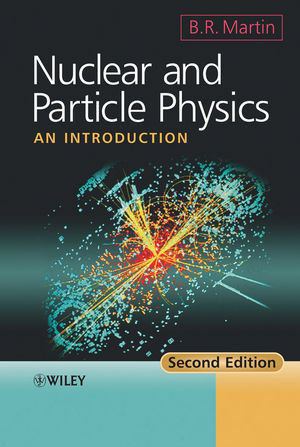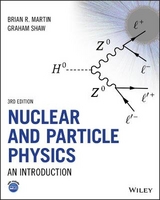
Nuclear and Particle Physics
Wiley-Blackwell (Verlag)
978-0-470-74274-7 (ISBN)
- Titel erscheint in neuer Auflage
- Artikel merken
An accessible introduction to nuclear and particle physics with equal coverage of both topics, this text covers all the standard topics in particle and nuclear physics thoroughly and provides a few extras, including chapters on experimental methods; applications of nuclear physics including fission, fusion and biomedical applications; and unsolved problems for the future. It includes basic concepts and theory combined with current and future applications. An excellent resource for physics and astronomy undergraduates in higher-level courses, this text also serves well as a general reference for graduate studies.
Professor Brian R Martin, formerly of: Department of Physics & Astronomy, University College London, London, UK Brian Marin was an undergraduate at Birmingham University and then moved to University College (1962-1964) to take a PhD in Theoretical Physics. During 1964/65 he was a Ford Foundation Fellow at the Institute for Theoretical Physics, Copenhagen University, and for 1965/66 held a NATO Postdoctoral Fellowship at the Neils Bohr Institute, Copenhagen. He then spent two years (1966-68) as a Research Associate in the Physics Department of Brookhaven National Laboratory, New York, before returning to UCL as a Lecturer. He served as Head of Department from 1993 to 2004. His research interests have been the phenomenology of elementary particle physics, with particular emphasis on analyses using models that incorporate as much firm general physical theory as possible and the extraction of reliable information from data. He has written two books on particle physics, one at graduate level on pion-pion interactions and the other a general introduction to the field for advanced undergraduates.
Preface to Second Edition. Notes. 1. Basic Concepts. 1.1 History. 1.2 Relativity and Antiparticles. 1.3 Space-Time Symmetries and Conservation Laws. 1.4 Interactions and Feynman Diagrams. 1.5 Particle Exchange: Forces and Potentials. 1.6 Observable Quantities: Cross-sections and Decay Rates. 1.7 Units: Length, Mass and Energy. Problems. 2. Nuclear Phenomenology. 2.1 Mass Spectroscopy . 2.2 Nuclear Shapes and Sizes. 2.3 Semi-Empirical Mass Formula: the Liquid Drop Model. 2.4 Nuclear Instability. 2.5 Radioactive Decay. 2.6 betaDecay Phenomenology. 2.7 Fission. 2.8 gammaDecays. 2.9 Nuclear Reactions. Problems. 3. Particle Phenomenology. 3.1 Leptons. 3.2 Quarks. 3.3 Hadrons. Problems. 4. Experimental Methods. 4.1 Overview. 4.2 Accelerators and Beams. 4.3 Particle Interactions with Matter. 4.4 Particle Detectors. 4.5 Multi-Component Detector Systems. Problems. 5. Quark Dynamics: The Strong Interaction . 5.1 Colour. 5.2 Quantum Chromodynamics (QCD). 5.3 Heavy Quark Bound States. 5.4 The Strong Coupling Constant and Asymptotic Freedom. 5.5 Quark-Gluon Plasma. 5.6 Jets and Gluons. 5.7 Colour Counting. 5.8 Deep Inelastic Scattering and Nucleon Structure. Problems. 6. Weak Interactions And Electroweak Unification. 6.1 Charged and Neutral Currents. 6.2 Symmetries of the Weak Interaction. 6.3 Spin Structure of the Weak Interactions. 6.4 W+ and Z 0 Bosons. 6.5 Weak Interactions of Hadrons: Charged Currents. 6.6 Meson Decays and CP Violation. 6.7 Neutral Currents and the Unified Theory. Problems. 7. Models And Theories Of Nuclear Physics . 7.1 The Nucleon-Nucleon Potential. 7.2 Fermi Gas Model. 7.3 Shell Model. 7.4 Non-Spherical Nuclei. 7.5 Summary of Nuclear Structure Models. 7.6 alpha-Decay. 7.7 beta-Decay. 7.8 gamma-Emission and Internal Conversion. Problems. 8. Applications Of Nuclear Physics. 8.1 Fission. 8.2 Fusion. 8.3 Nuclear Weapons. 8.4 Biomedical applications. Problems. 9. Outstanding Questions and Future Prospects. 9.1 Overview. 9.2 Hadrons and Nuclei . 9.3 The Origin of Mass: the Higgs Boson . 9.4 The Nature of the Neutrino. 9.5 Beyond the Standard Model: Unification Schemes. 9.6 Particle Astrophysics. 9.7 Nuclear Medicine. 9.8 Power Production and Nuclear Waste. Appendix A: Some Results In Quantum Mechanics. A.1 Barrier Penetration. A.2 Density of States. A.3 Perturbation Theory and the Second Golden Rule. A.4 Isospin Formalism. A.4.1 Isospin operators and quark states. A.4.2 Hadron states. Appendix B: Relativistic Kinematics. B.1 Lorentz Transformations and Four-Vectors. B.2 Frames of Reference. B.3 Invariants. Problems B. Appendix C: Rutherford Scattering. C.1 Classical Physics. C.2 Quantum Mechanics. Problems C. Appendix D: Gauge Theories. D.1 Gauge Invariance and the Standard Model. D.1.1 Electromagnetism and the gauge principle. D.1.2 The standard model. D.2 Particle Masses and the Higgs Field. Appendix E: Data. E.1 Physical Constants and Conversion Factors. E.2 Tables of Particle Properties. D.2.1 Gauge bosons. D.2.2 Leptons. D.2.3 Quarks. D.2.4 Baryons. D.2.5 Mesons. E.3 Tables of Nuclear Properties. D.3.1 Properties of naturally occurring isotopes. D.3.2 The periodic table. Appendix F: Solutions To Problems. References. Bibliography. Index.
| Verlagsort | Hoboken |
|---|---|
| Sprache | englisch |
| Maße | 180 x 252 mm |
| Gewicht | 894 g |
| Themenwelt | Naturwissenschaften ► Physik / Astronomie ► Atom- / Kern- / Molekularphysik |
| Naturwissenschaften ► Physik / Astronomie ► Hochenergiephysik / Teilchenphysik | |
| ISBN-10 | 0-470-74274-7 / 0470742747 |
| ISBN-13 | 978-0-470-74274-7 / 9780470742747 |
| Zustand | Neuware |
| Haben Sie eine Frage zum Produkt? |
aus dem Bereich



